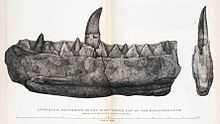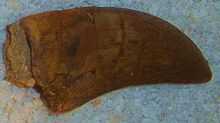1824 in paleontology
| List of years in paleontology |
|---|
| ... 1814 . 1815 . 1816 . 1817 . 1818 . 1819 . 1820 ... 1821 1822 1823 -1824- 1825 1826 1827 ... 1828 . 1829 . 1830 . 1831 . 1832 . 1833 . 1834 ... In science: 1821 1822 1823 -1824- 1825 1826 1827 |
| Art . Archaeology . Architecture . Literature . Music . Philosophy . Science +... |
Paleontology, palaeontology or palæontology (from Greek: paleo, "ancient"; ontos, "being"; and logos, "knowledge") is the study of prehistoric life forms on Earth through the examination of plant and animal fossils.[1] This includes the study of body fossils, tracks (ichnites), burrows, cast-off parts, fossilised feces (coprolites), palynomorphs and chemical residues. Because mankind has encountered fossils for millennia, paleontology has a long history both before and after becoming formalized as a science. This article records significant discoveries and events related to paleontology that occurred or were published in the year 1824.
Dinosaurs
- William Buckland realizes that fossils he previously believed to be of cetacean origin were actually Iguanodon fossils. This mistake cost him the chance to describe the genus himself.[2]
Newly named dinosaurs
| Taxon | Novelty | Status | Author(s) | Age | Unit | Location | Notes | Images |
|---|---|---|---|---|---|---|---|---|
|
"Iguanosaurus"[3] |
Gen. nov. |
Tilgate Forest[3] |
"Iguanosaurus" was first mentioned in a magazine article by an anonymous author (possibly Mantell) in 1824. The author suggested that Mantell was originally going to name the teeth "Iguanosaurus", but William Daniel Conybeare suggested that it was instead named Iguanodon. That name was shorter and euphonious, and is what Mantell named the animal in 1825.[3] |
| ||||
|
Gen. nov. |
Valid |
The Reverend William Buckland gives a presentation to the Geological Society describing the first scientifically named dinosaur, Megalosaurus on February 20. Later that year its formal scientific description is published in writing.[2] The first named species, M. cornybeari, is named in 1826 by Ferdinand von Ritgen,[7] but became a nomen oblitum. The year after the naming of M. cornybeari, the current type species M. bucklandii is named by Mantell, honoring Buckland.[8] Many more species are later named under Megalosaurus.[9] |
| |||||
Plesiosaurs
New taxa
| Taxon | Novelty | Status | Author(s) | Age | Unit | Location | Notes | Images |
|---|---|---|---|---|---|---|---|---|
|
Plesiosaurus dolichodeirus[10] |
Sp. nov. |
Valid |
William Daniel Conybeare[10] |
Sinemurian, 199 mya[10] |
Cornybeare named the genus in 1821, following up with the type species P. dolichodeirus in 1824. The species was named on the basis of a complete skeleton discovered by Mary Anning.[10] |
| ||
References
- ↑ Gini-Newman, Garfield; Graham, Elizabeth (2001). Echoes from the past: world history to the 16th century. Toronto: McGraw-Hill Ryerson Ltd. ISBN 9780070887398. OCLC 46769716.
- ↑ 2.0 2.1 Farlow, J.O.; Brett-Surmann, M.K. (1999). The Complete Dinosaur. Indiana University Press. pp. 8–9. ISBN 0-253-21313-4.
- ↑ 3.0 3.1 3.2 3.3 Delair, J.B.; Sarjeant, W.A.S. (1975). "Earliest Discoveries of the Dinosaurs". Isis 66 (1): 4–25. doi:10.1086/351373. JSTOR 229523.
- ↑ Carpenter, K.; Ishida, Y. (2010). "Early and "Middle" Cretaceous Iguanodonts in Time and Space". Journal of Iberian Geology 36 (2): 145–164. doi:10.5209/rev_JIGE.2010.v36.n2.3.
- ↑ Buckland, W. (1824). "Notice on the Megalosaurus, or great fossil lizard of Stonesfield". Transactions of the Geological Society of London 2 (1): 390–396.
- ↑ 6.0 6.1 Benson, R.B.J. (2009). "An assessment of variability in theropod dinosaur remains from the Bathonian (Middle Jurassic) of Stonesfield and New Park Quarry, UK and taxonomic implications for Megalosaurus bucklandii and Iliosuchus incognitus". Palaeontology. doi:10.1111/j.1475-4983.2009.00884.x.
- ↑ von Ritgen, F.A. (1826). "Versuchte Herstellung einiger Becken urweltlichter Thiere". Nova Acta Academiae Caesareae Leopoldino-Carolinae Germanicae Naturae Curiosorum 13: 331–358.
- ↑ Mantell, G. (1827). "Illustrations of the geology of Sussex: a general view of the geological relations of the southeastern part of England, with figures and descriptions of the fossils of Tilgate Forest". Fellow of the Royal College of Surgeons: 92.
- ↑ Benson, R.; Brusatte, S.; Hone, D.; Naish, D.; Xu, X.; Anderson, J.; Clack, J.; Duffin, C.; Milner, A.; Parsons, K.; Prothero, D.; Johanson, Z.; Dennis-Bryan, K. (2012) [2009]. Ambrose, Jamie; Gilpin, David; Hirani, Salima; Jackson, Tom; Joyce, Nathan; Maiklem, Lara; Marriott, Emma; Nottage, Claire; van Zyl, Meizan, eds. Prehistoric Life: A Definitive Visual History of Life on Earth. Dorling Kindersley. pp. 1–512. ISBN 978-0-7566-9910-9. OCLC 444710202.
- ↑ 10.0 10.1 10.2 10.3 10.4 Storrs, G.W. (1997). "Morphological and taxonomic clarification of the genus Plesiosaurus". In Callaway, J.M; Nicholls, E.L. Ancient Marine Reptiles. Academic press. pp. 145–190.






